Charles Blomfield stands as a significant figure in New Zealand's art history, primarily celebrated for his meticulous and evocative paintings of the country's unique landscapes. Born in London, England, in 1848, Blomfield emigrated with his family to New Zealand in 1863, settling in Auckland. This move marked the beginning of a lifelong engagement with the natural beauty of his adopted homeland, which he would capture with remarkable dedication and skill. Though initially working in other trades, his passion for art eventually led him to become one of the most recognized painters of his era in New Zealand, leaving behind a legacy intrinsically linked to the nation's identity and its lost natural wonders.
His work, particularly his depictions of the now-destroyed Pink and White Terraces of Lake Rotomahana, serves not only as artistic expression but also as an invaluable historical record. Blomfield's commitment to realism and his ability to convey the atmosphere and specific details of the New Zealand environment cemented his place in the country's cultural heritage. He became a chronicler of a landscape undergoing significant change, both natural and man-made, during the colonial period.
Early Life and Arrival in New Zealand
Charles Blomfield was born into a London family with artistic inclinations; his father, also named Charles, worked as a plumber, painter, and decorator. This early exposure likely fostered young Charles's interest in the visual arts. The Blomfield family, seeking new opportunities, made the momentous decision to emigrate when Charles was a teenager. They arrived in Auckland aboard the sailing ship 'Annie Wilson' in 1863, joining a wave of British settlers shaping the future of the colony.
Upon arrival, the family established themselves in Auckland. Charles initially followed in his father's footsteps, working in the decorating and sign-writing trade. This practical experience likely honed his skills in handling paint and understanding composition, providing a foundation for his later artistic pursuits. Auckland, at that time, was a burgeoning colonial capital, offering a dynamic environment but limited formal art training opportunities compared to London.
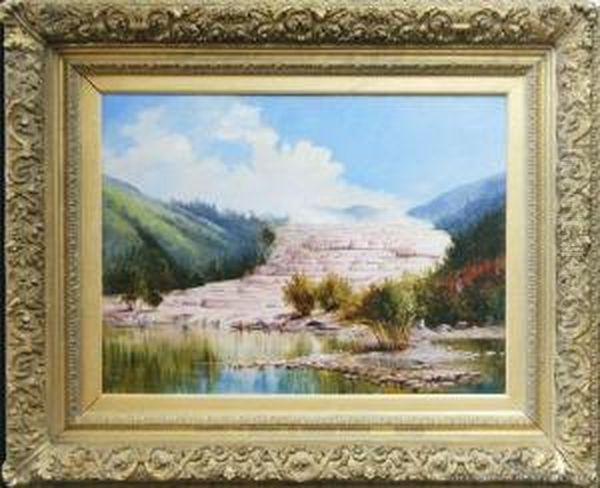
Despite the lack of formal art schools in the European tradition, Blomfield was driven by a desire to paint. He is largely considered self-taught, likely learning much from his father and through personal observation and practice. The stunning natural environment of New Zealand, vastly different from the English landscapes of his birth, provided ample inspiration. He began to dedicate more time to landscape painting, venturing into the surrounding countryside to sketch and paint directly from nature.
Artistic Development and Style
Blomfield's artistic style developed within the prevailing tastes of the Victorian era, emphasizing realism and detailed observation. He possessed a keen eye for topographical accuracy, aiming to represent the landscapes he encountered faithfully. His works often exhibit meticulous attention to geological formations, foliage, and the specific quality of light found in New Zealand. This dedication to detail gave his paintings a documentary quality, which later proved immensely valuable.
He travelled extensively throughout the North Island of New Zealand, seeking out dramatic and picturesque scenery. His journeys took him to the volcanic regions of the central North Island, the dense Kauri forests of the north, coastal areas, and mountainous terrains. These expeditions provided the raw material for his canvases, which he often completed back in his Auckland studio based on sketches and memory.
Blomfield became particularly adept at capturing the effects of light and atmosphere. His paintings often convey the clarity of the New Zealand air, the reflections on water surfaces, and the interplay of sunlight and shadow across complex terrains. While primarily realistic, his work sometimes carries a romantic sensibility, imbuing the landscapes with a sense of awe and wonder, reflecting the 19th-century fascination with the sublime power of nature. His preferred medium was oil paint, which allowed him to build up layers of colour and detail to achieve the desired effects.
The Pink and White Terraces: An Enduring Legacy
Charles Blomfield's name is inextricably linked with the Pink and White Terraces (Otukapuarangi and Te Tarata), silica sinter formations that were once considered one of the natural wonders of the world. Located at Lake Rotomahana near Rotorua, these cascading terraces, formed by geothermal springs, attracted international tourists and were a subject of immense fascination. Blomfield first visited the Terraces in the 1870s and was captivated by their unique beauty.
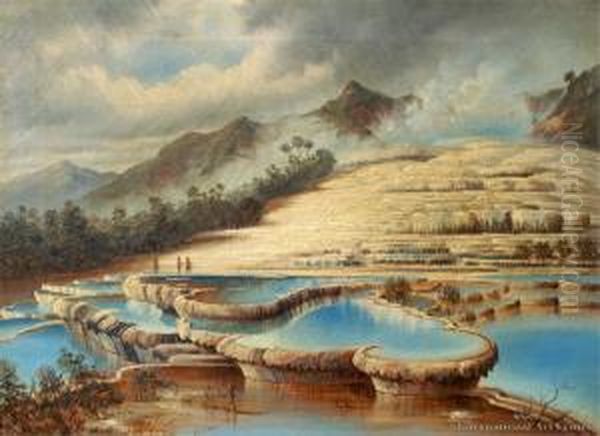
He returned multiple times before their destruction, sketching and painting them from various angles and under different light conditions. His most famous works, The Pink Terraces and The White Terraces, are detailed and luminous depictions of these geological marvels. He captured the delicate pink hues of Otukapuarangi, caused by traces of iron oxides, and the dazzling, Parian marble-like appearance of the larger Te Tarata (the White Terraces). These paintings showcased the intricate formations of the silica basins, the steaming water, and the surrounding volcanic landscape.
Blomfield's paintings of the Terraces were not merely picturesque views; they were careful studies of a unique natural phenomenon. He sought to convey their scale, their texture, and the almost ethereal atmosphere created by the geothermal activity. These works quickly gained popularity, resonating with both local residents and visitors who marvelled at New Zealand's geothermal wonders. They became iconic images, reproduced and widely admired.
The Tarawera Eruption and its Aftermath
The fate of the Pink and White Terraces, and consequently the significance of Blomfield's paintings, was dramatically altered on June 10, 1886. The catastrophic eruption of Mount Tarawera, a volcano adjacent to Lake Rotomahana, completely destroyed the Terraces, burying them under mud and volcanic debris and reshaping the entire landscape. The event was a national tragedy, causing loss of life and obliterating a world-renowned natural wonder.
In the wake of the eruption, Blomfield's pre-eruption paintings of the Terraces took on immense historical importance. They transformed from contemporary landscape depictions into precious visual records of a lost paradise. Suddenly, his canvases were among the most accurate and detailed representations available of what the Terraces had looked like. This cemented Blomfield's reputation and created a surge in demand for his work.
Blomfield himself visited the devastated area after the eruption, documenting the changed landscape. He painted scenes of the ash-covered terrain and the altered Lake Rotomahana, capturing the stark, desolate beauty of the post-eruption environment. These later works provide a poignant contrast to his earlier, idyllic depictions of the Terraces, highlighting the destructive power of nature and the ephemeral quality of even the most seemingly permanent landmarks. The eruption ensured that Blomfield's Terrace paintings would forever be his most sought-after and historically significant works.
Other Subjects and Artistic Output
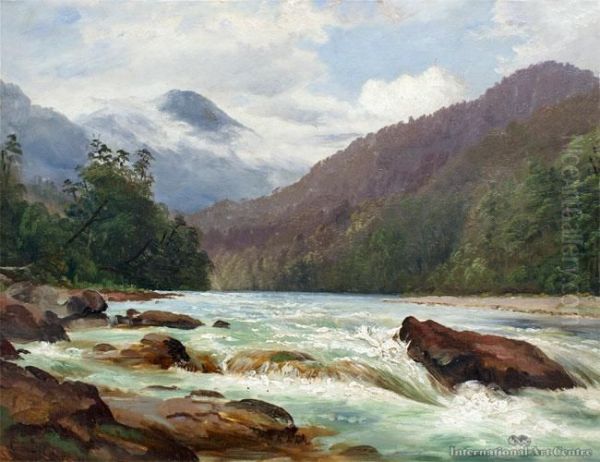
While the Pink and White Terraces became his signature subject, Charles Blomfield's artistic interests extended to a wide range of New Zealand landscapes. He was particularly drawn to the majestic Kauri forests of the Northland region. His paintings of these ancient forests capture the towering scale of the Kauri trees, the intricate play of light filtering through the dense canopy, and the lush undergrowth of ferns and epiphytes. These works serve as important records of forests that were heavily logged during the colonial era.
Blomfield also painted coastal scenes, capturing the rugged beauty of New Zealand's shorelines, harbours, and islands. His works often feature dramatic cliffs, crashing waves, and the distinctive quality of coastal light. Mountainous regions, such as the Southern Alps (though less frequently depicted than North Island scenes), also appeared in his oeuvre. He occasionally included figures in his landscapes, sometimes Maori, sometimes settlers, which added narrative elements and a sense of scale, though his primary focus remained the land itself.
He was a prolific artist throughout his career, producing a large body of work. His dedication meant that he often revisited subjects, creating multiple versions of popular scenes. This prolific output made his work accessible to a wider audience but also led to criticism from some quarters later in his career, who felt his work became repetitive, particularly his numerous copies of the Terraces painted to meet market demand after the eruption.
Exhibitions and Recognition
Charles Blomfield actively participated in the burgeoning art scene of colonial New Zealand. He regularly exhibited his work with organizations such as the Auckland Society of Arts (of which he was a member and served on the council) and other art societies throughout the country. His paintings were often well-received by the public and critics, praised for their technical skill, faithfulness to nature, and appealing subject matter.
An exhibition held in 1896, featuring his series of paintings of the Pink and White Terraces, garnered significant attention, as noted in contemporary newspaper reports like the New Zealand Herald. Such exhibitions helped solidify his reputation as a leading landscape painter. His work was seen as contributing to the development of a distinctly New Zealand school of painting, focused on capturing the unique character of the local environment.
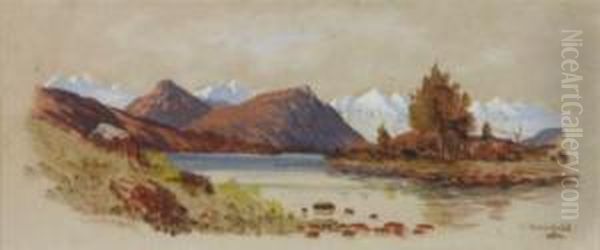
However, his critical reception was not uniformly positive, especially later in his life. As artistic tastes began to shift towards the end of the 19th and early 20th centuries, with the influence of Impressionism and Post-Impressionism reaching New Zealand, Blomfield's adherence to detailed Victorian realism was sometimes seen as conservative or old-fashioned. The criticism of being a "one-trick pony" or overly commercial stemmed largely from the sheer number of Terrace paintings he produced, driven partly by financial necessity. Despite these critiques, his popularity with the public remained considerable.
Contemporaries and Artistic Context
Charles Blomfield worked during a formative period for professional art in New Zealand. He was part of a generation of artists, both immigrant and locally born, who sought to interpret the New Zealand landscape through predominantly European artistic conventions. His contemporaries in the New Zealand art scene included figures like John Gully (1819-1888) and John Kinder (1819-1903), known for their watercolour landscapes, and J.C. Hoyte (1835-1913), another painter of the Terraces.
Later contemporaries who brought different styles to New Zealand included the Dutch-born Petrus van der Velden (1837-1913), known for his more expressive and dramatic style, and the Italian Girolamo Pieri Nerli (1860-1926), who introduced impressionistic influences. Perhaps the most famous New Zealand artist of the era, Charles F. Goldie (1870-1947), known for his detailed portraits of Maori, was also active during Blomfield's later career. Interestingly, Goldie provided some instruction to Blomfield's daughter, Elizabeth (Bessie) Blomfield, who also became a painter under her father's tutelage. Other notable New Zealand landscape artists of the general period include Alfred Sharpe (c.1836-1908) and later, Frances Hodgkins (1869-1947), who moved towards modernism.
Internationally, Blomfield's adherence to realism places him within the broader context of Victorian art. While geographically distant, his work shares sensibilities with British landscape traditions. The wider art world during his lifetime saw immense changes, from the Pre-Raphaelites like Dante Gabriel Rossetti (1828-1882) and John Everett Millais (1829-1896), to the Aesthetic Movement featuring artists like James Tissot (1836-1902), and the detailed historical scenes of Lawrence Alma-Tadema (1836-1912). Realists like Ford Madox Brown (1821-1893) and landscape specialists like George Price Boyce (1826-1897) were also part of this complex artistic milieu, though direct influence on Blomfield is unlikely. Blomfield's focus remained firmly on the New Zealand scene.
Later Life and Legacy
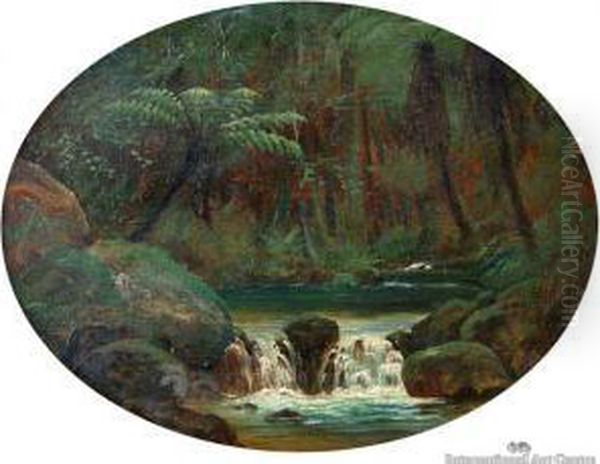
In his later years, Charles Blomfield continued to paint from his Auckland studio. The demand for his Terrace paintings persisted long after the eruption, providing a source of income but also contributing to the perception that his artistic range had narrowed. He faced financial challenges, particularly as newer art styles gained favour and the market changed. Nevertheless, he remained a respected figure in the Auckland community.
He passed away in Auckland in 1926 at the age of 78. He left behind a substantial body of work that continues to be appreciated for its artistic merit and historical significance. His paintings are held in major public collections throughout New Zealand, including Te Papa Tongarewa (the Museum of New Zealand), Auckland Art Gallery Toi o Tāmaki, and Rotorua Museum Te Whare Taonga o Te Arawa.
Charles Blomfield's enduring legacy lies primarily in his role as the foremost visual chronicler of the Pink and White Terraces. His detailed and evocative paintings ensure that this lost natural wonder remains vivid in the cultural memory of New Zealand and the world. Beyond the Terraces, his broader work provides valuable insights into the landscapes and environments of 19th-century New Zealand, capturing scenes of Kauri forests, coastlines, and volcanic regions with a dedicated, realistic eye. He remains a key figure in the narrative of New Zealand art history.
Conclusion
Charles Blomfield's journey from a London emigrant to a celebrated New Zealand landscape painter is a testament to his dedication and artistic vision. His meticulous depictions of the Pink and White Terraces, transformed by the Tarawera eruption into invaluable historical documents, secure his unique place in art history. While working within the conventions of Victorian realism, he successfully captured the distinct character and atmosphere of the New Zealand landscape. His extensive body of work continues to offer viewers a window into the natural beauty of 19th-century New Zealand, preserving views of iconic landmarks and environments, some of which have since been irrevocably changed. Blomfield remains an important and accessible artist whose work resonates with themes of natural wonder, loss, and the enduring power of place.